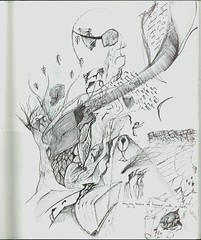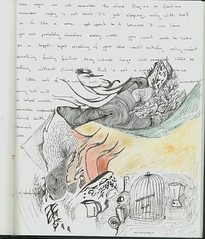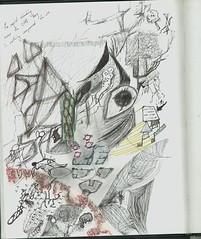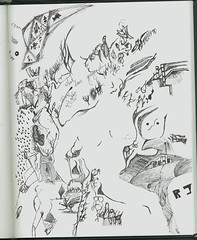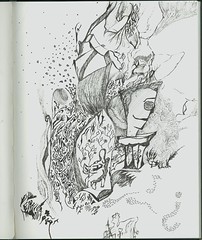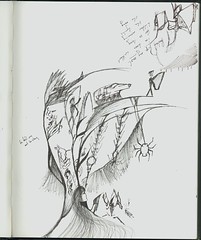candle wax
and green gas
tequila things and strawberry hats
insignificant little chats.
an arthouse
a shithouse
Rory B. Bellows
Labels: art
Labels: art
The differences between Gadamer and Derrida are best highlighted when examining how each method deals with a subject coming to understand the alien or other. The subject and the other reach a compromise via conversation, which is helped by a common ground of understanding that is made possible by a mutual trust within tradition. By using a common ground in language, the subject and the other can come to what Gadamer labels as a fusion of horizons. Where the perspectives of the two characters comes to an agreement or compromise. This is a new understanding derived from the basis of a tradition. However Gadamer persists that the compromise does not result in a complete understanding of the other, but rather that the act of engagement reveals more about the subject’s self to itself. Gadamer also uses this act of engagement within the bounds of interpreting texts, in the sense that when one interprets a text, their interpretation is more so a revelation about the self than the text one is interpreting. The use of the English Literature Canon is a normative example of texts that transcend their original context and are used in a contemporary context to be constantly interpreted, not in order to understand the text, but so that each generation can in turn come to understand itself better.
“The concept of the classical is capable of being extended to any ‘development’ to which an immanent telos gives unity.”
“The classical is something that resists historical criticism because its historical dominion, the binding power of the validity that is preserved and handed down, precedes all historical reflection and continues in it.”
In this case the classical works of literature represent the tradition by which we have come to place our trust and thus provides a common ground. The text, it is pre-supposed, has an inherent coherency and overall meaning. That is to say that the text was written with intent and therefore presents a reality of the world in which we exist. It is the method in which that we interpret meaning that Gadamer sets about a hermeneutic project. A project that defines the process of interpretation by projecting structures of totality and coherence upon a text, while analysing the detail. This constant re-evaluation between the detail and the subject’s projection of a coherent whole is the hermeneutic circle.
Derrida’s account of the history of philosophy involves new understanding coming about from a tearing from the past. Rather than the neat synthesis of concepts that evolve throughout the Hegelian model, there is meaning to be found within the differential relations of concepts. By understanding the discrimination of the other, the bridge between two concepts, therein lie an understanding that does not have a dichotomy and cannot be deferred onto yet another synthesis. Rather than a neat coming together of ideas, as an ideal fusion of horizons, Derrida offers another origin of meaning. The ruptures, or disembarking from tradition, give an account of a history of understanding. A breaking free of the limitations that human understanding has, at a point in time, encountered – the limitation that cause understanding to stagnate. In contrast to the hermeneutic circle that Gadamer draws his focus toward, Derrida is absorbed in removing, or at least changing positively, what Gadamer labels as fore-structure. The fore-structure, which projects onto a text before interpretation, is according to Gadamer changeable, but necessary, and made aware to the subject at the point of interpretation of the text. Deconstructionalist arguments suggest that Gadamer’s model of these fore-structures and their representation within authority for the sake of wiping out misunderstanding is too conservative. This makes it more difficult for the individual to affect change in the fore-structure. Arguably the core presumption of every text being coherent and whole is one that Derrida attempts to lay aside, not only in argument, but also within his very writing style. Rather than a hermeneutic circle Derrida pursues the project of differánce.
The hermeneutic project for Gadamer begins with a removal of the Historical consciousness that embraces the objective as a viewpoint, or even the striving of a neutral viewpoint. For even the will to be neutral, and to actually be neutral in one’s perspective, is a set of prejudices to be acknowledged and interpreted within context. What the hermeneutic project involves therefore is a reinstatement of prejudices, not as an unidentified force, but as a set of filters that are to be present in one’s interpretation, and always made available for improvement. This embraces a Kantian idea of knowledge springing from experience, as defined as phenomena; the individual gains knowledge from his experiences and interaction with the world. Since the individual, Dasein, is also embedded within the world, or makes up the world one is in, then Gadamer insists that the removal of experience from the subjective realm is a form of alienation, thus making the individual an other to himself.
“Man is alien to himself and his historical fate in a way quite different from the way nature, which knows nothing of him, is alien to him.”
Change of prejudices, fore-structure, comes about through a new experience, one that challenges the understanding of previous knowledge of such an experience. Self-examination needs to be different from examination of the other, because it is a result of an examination of the other that conflicts with one’s normative values. Even the empirical sciences have a set of normative values that are revered, but are overturned by conflicting evidence that is achieved via the normative dialogue pursued within the fields of the empirical science. The hermeneutic project must embrace the existence of the subjective prejudices that are inherent within the individual toward everything one experiences within the world. Upon this embrace it is possible for the hermeneutic project to recognise and then collapse the differences between the prejudices of the subject and the other, and the prejudices of the subject and the object of [new] experience.
Gadamer’s new historicism sets out to understand the set of conditions for individual epochs of history. In this sense historicism can be concerned with context of thought and its interpretation rather than its place within a grand narrative. This historicism allows for a diversity of histories to be understood in their own context, without resorting to pseudo-relativism, because the truth, as represented by an authority, is how the generation of the epoch interpreted and understood themselves. This is an internal explanation – an examination of subjective interpretation within its own context, which if it were to be interpreted by another epoch would in turn be subjected to its own set of subjective prejudices that would be accommodated by Gadamer’s account of historicism. However this faces some limitations. The diverse contextual truth does not allow for a trans-epochal truth, a universal. Then the epochal truths cannot be defined to boundaries of time or a set period in thought. The limitations to this model of history of philosophy, themselves, are not problematic to Gadamer’s argument, in fact Gadamer insists on a lack of universal truth, however the issues they raise do become problematic for Gadamer’s project. The insistence of a non-existence of universals is problematic due to the nature of hermeneutics, and its aims, being representative of a universal. That is the hermeneutic circle is relevant throughout the epochs that Gadamer wishes to assign personal histories, separate from a meta-history, and is used, perhaps not knowingly so as to consciously change one’s prejudices, but as a model of Dasein’s development of prejudice, and the use of a fore-structure when approaching a text, is universal in its nature. The boundaries of the epochs may be defined, not by time, but by the continuation of strands of common knowledge by individuals throughout time. In a sense this can be understood as the epoch not being carried by time and time’s boundaries, but by the individuals themselves who incorporate the distinguishing mark of an epoch. This way an epoch carries over time, can die out and resurface over time, but the history and subjective truths are carried regardless. However, not unlike the problem of universals, this definition of epoch flies in the face of tradition being a stronghold for prejudices for the sake of limiting misunderstanding, but remaining fluid enough for continual re-assessment. An epoch cannot be defined individuals retaining the common ground, because that is the place of tradition, which has a featured time, and if tradition does not have a featured time then the authority is overly conservative and not allowing for continual re-assessment of its grounds for understanding.
Derrida argues that we are not as bound to tradition as to entrust in it a need for common ground. The inner experiences that Bataille examines in context to Hegel are what Derrida claims to be grounds for a radical break away from tradition. These inner experiences, concepts that do not defer onto other concepts, that are not only self-defined within Dasein, but also lack a solid definition of any kind, do not escape the Hegelian model, but exist as the space within the machination of the Hegelian dialectic. The prejudices of Dasein need not be supported by tradition in any sense, but can be accumulated by these inner expressions and non-concepts. In a similar way Derrida’s notion of differánce works to accumulate meaning and understanding that exists not in the words or text alone but within the differences between the concepts. The difference between the texts as it is written, as it is spoken, and then as it is translated, transcribes, so on and so forth. The understanding of prejudice and interpretation therefore is not bound to a tradition that harbors a framework of thesis, antithesis and synthesis, but is flexible to non-concepts such as emotion, tone, intonation, and spelling. In this model there is no need for an authority to house libraries of concepts and their normative values, but rather this is represented by Dasein understanding the differánce between concepts being used and conflicting against their prejudices. From this arises rifts from tradition, which are the threads for change in prejudice, understanding and the history of philosophy. Only a rehabilitated notion of an authority that is not dogmatic and allows for perpetual re-evaluation by free-thinkers will allow Gadamer’s system to function as first desired.
To change the tradition of common understanding, the participants of a society must use an ethic of conversation; this will create their own subjective epoch. Since new experiences bring about recognition of prejudice, and the recognition of prejudice brings about a change in prejudice, the ethic of conversation must be widespread to make it common. So much so that it must be taken as a responsibility of the individual who experiences something new, something shocking, a conflict of some kind, to share this experience with others as much as possible. The ethic must insist that subjects attempt to explore new horizons perpetually, so as the authority may be perpetually challenged. In dialogue our predispositions can change throughout and will thus broaden our sense of fore-structure. In this way a worldview may change if many, if all, enter into this dialogue of the other, or new. When everyone participates in this world dialogue of challenging their own perspectives, and challenging the accepted normative value system, then a broader understanding of how we understand comes about. This is what Gadamer explains when he examines the ethic of conversation that is life altering, and keeps authority in check. The purpose of tradition is clearly highlighted as a grounding sense only, as a place one can look back on and realise it, tradition, as a starting point. This interaction with the world and looking back at tradition highlights the tensions between our relative horizons of understanding and the differences between them.
The deconstructionist approach has a concern with the lack of freedom to change within the confines of the hermeneutic project, and in particular the structure of the hermeneutic circle. Rather than being a catalyst for change, in regards to one’s prejudice, the hermeneutic circle supports a homogenisation of prejudices to a goal of increased similarity. The fear in the hermeneutic circle is based on the potentiality that people will develop an over familiarity with the institutions that are entrusted with tradition, the set of normative values, and are not motivated to new experience. Since Gadamer’s model rests solely on the experience of the new to effect change within the fore-structure, an over trust in tradition would counter the idealistic motivation of complete knowledge. This demotivation to change may be circumvented by an understanding of multiple traditions. However Gadamer maintains the importance of a single tradition over an epoch as a point of reference for the generation’s understanding of itself. Yet this overarching tradition of authority is not objective, it is the respected, unchallenged, set of subjective fore-structures that, for Gadamer, define the epoch. On the other hand Derrida breaks the world into a network of nodes, whose relationships form the locus of meaning. In Derrida’s account of a network forming a basis of meaning, change within meaning occurs in the fluidity of language. The issues of conservative change that critique Gadamer do not have a basis from which to attack Derrida.
Through Derrida’s account of Bataille we can see a distinct relationship between tradition and meaning. Bataille explores the inner machinations of what he calls inner experience, which are concepts that are full of meaning and completely devoid of it. They hold onto the Hegelian concept of Aufhebung; maintaining while suppressing. These inner experiences exist without dichotomy, and without the ability to defer meaning. Bataille argues that these inner concepts are known to the subject, but their concept cannot be understood linguistically and therefore cannot be part of the Hegelian dialectic. These concepts form a part of non-knowledge; they are not contained within the authority that Gadamer proposes to develop for common understanding. Each individual understands these inner experiences, of love, laughter, on a completely individual set of terms that cannot be communicated to an other. From this Derrida draws a sliding of linguistic meaning, which forms the networks that build a locus of meaning. That is one can speak without saying anything of meaning. The meaning is gained from the relationship and context of the words used in dialogue. The meaning is present within the dialogue, obtained by understanding the subtlies of the form in which the dialogue takes place. Although Saussiere empowers speech act over the written from, Derrida attempts to show that each form of a text has its own set of relationships that contain meaning. This performance of text is explained by the term differánce; the linguistic spelling of differánce itself is telling of the meaning that is conveyed not by the concept, but by the form the concept takes place in the world. The differánce exists previous to any fore-structure, that is approaching the text expecting totality and coherence, and also previous to the dialectic of the Hegelian model. Derrida’s act of writing is in itself an example of how one may come to understand it’s meaning through its relationship to the form the text takes, and not specifically with models of coherence.
Even Gadamer speaks of an excess of meaning that escapes interpretation, which he then uses as a source of motivation to spur on an eternal interpretation in order that one may capture the excess. Gadamer makes sense of these limitations upon interpretation as knowledge of the incompleteness of one’s knowledge and therefore recognition that one must remain open-minded to accept experiences that will challenge prejudices. However if one is to understand Derrida’s concept of differánce, this excess of meaning can be explained as an articulation of differences within a pattern of a text. Within the context of the metaphysic of presence one may gain an understanding via the patterns of difference that accumulate in the excess meaning that escape in interpretation. Derrida understands these patterns as evidence of the lack of whole meaning within any synthesis. Stretching this point to an extreme, one may view this process as a redefinition of Gadamer’s hermeneutic circle. That a meaning is derived from understanding the patterns of difference that escape the text in context of the whole text. The details, which are examined in the hermeneutic circle, are instable and changeable. The details, patterns of difference, allow for ruptures and instability within a text, which, according to Derrida, bring about a deviation from tradition.
While Gadamer’s project is aimed at a perpetual interpretation, fuelled by an unreachable ideal of a fusion of horizons, the hermeneutic circle poses a structure of understanding one’s own prejudice in light of experience. The fusion of horizons does lead to a common ground between the subject and the other, but cannot breach the distance between the two. Both Gadamer and Derrida must accept that some meaning escapes from interpretation. How each deals with what escapes is fundamentally their respective differences in the history of philosophy. Derrida insists that what is left out leads to a certain misunderstanding between the subject and the other. The exclusions cannot be re-written into the other, they cannot be re-written into the whole, or tradition itself, but the relation between them can be sought after. This is where meaning is accredited. The space is importantly the meaning for Derrida, while for Gadamer it is a motivation. The space, escaped meaning, must exist for Gadamer. If it did not then the hermeneutic project would collapse, because the other would be wiped out, which means the potentiality for new experiences that lead to new understanding would not be possible.
Bibliography
Books
Bataille, Georges The Bataille Reader, Oxford Press, 1997
Derrida, Jacques Writing and Difference, University of Chicago Press, 1978
Derrida, Jacques Semiology and Grammatology: Interview with Julia Kristeva (1968), Ch.2 of Positions, University of Chicago Press, 1981
Derrida, Jacques Margins of Philosophy, University of Chicago Press, 1982
Gadamer, Hans-Georg Truth and Method, Second, Revised Ed. Continuum, 2004
Michelfelder, Diane & Palmer, Richard Dialogue and Deconstruction: The Gadamer-Derrida Encounter, State University of New York Press, 1989
Websites
Malpas, Jeff Hans-Georg Gadamer,
http://plato.stanford.edu/entries/gadamer/
Last accessed: 14/11/05
Mieszkowski, Jan Derrida, Hegel, and the Language of Finitude, http://www3.iath.virginia.edu/pmc/current.issue/15.3mieszkowski.html
Last accessed: 14/11/05
Nettlefold, Gwen Hegel, Bataille, Lacan,
http://foucault.info/Foucault-L/archive/msg03143.shtml
Last accessed: 14/11/05
Szabo, Nick Hermeneutics: An Introduction to the Interpretation of Tradition,
http://szabo.best.vwh.net/hermeneutics.html
Last accessed: 14/11/05
Gadamer, Hans-Georg Truth and Method, Second, Revised Ed. Continuum, 2004 pg 289
Ibid. pg 288
Ibid. pg 283
Derrida, Jacques Writing and Difference, University of Chicago Press, 1978 pg 255
Gadamer, Hans-Georg Truth and Method, Second, Revised Ed. Continuum, 2004 pg 269
Mieszkowski, Jan Derrida, Hegel, and the Language of Finitude, http://www3.iath.virginia.edu/pmc/current.issue/15.3mieszkowski.html
Last accessed: 14/11/05
Gadamer, Hans-Georg Truth and Method, Second, Revised Ed. Continuum, 2004 pg 273
Ibid. pg 275
Ibid. pg 279
Ibid. pg 273
Ibid. pg 277
Malpas, Jeff Hans-Georg Gadamer,
http://plato.stanford.edu/entries/gadamer/
Last accessed: 14/11/05
Ibid.
Derrida, Jacques Writing and Difference, University of Chicago Press, 1978 pg 252
Ibid. pg 254
Derrida, Jacques Margins of Philosophy, University of Chicago Press, 1982 pg 9
“But this is not the essence of authority. Admittedly, it is primarily persons that have authority; but the authority of persons is ultimately based not on the subjection and abdication of reason but on an act of acknowledgement and knowledge – the knowledge, namely, that the other is superior to oneself in judgement and insight and that for this reason his judgement takes precedence –i.e., it has priority over one’s own. This is connected with the fact that authority cannot actually be bestowed but is earned, and must be earned if someone is to lay claim to it. It rests on acknowledgement and hence on an act of reason itself which, aware of its own limitations, trusts to the better insight of others. Authority in this sense, properly understood, has nothing to do with blind obedience to commands. Indeed, authority has to do not with obedience but rather with knowledge.” - Gadamer, Hans-Georg Truth and Method, Second, Revised Ed. Continuum, 2004
“we are always situated within traditions, and this is no objectifying process – i.e., we do not conceive of what tradition says as something other, something alien. It is always part of us, a model or exemplar, a kind of cognizance that our later historical judgement would hardly regard as a kind of knowledge but as the most ingenuous affinity with tradition.” - Gadamer, Hans-Georg Truth and Method, Second, Revised Ed. Continuum, 2004
Gadamer, Hans-Georg Truth and Method, Second, Revised Ed. Continuum, 2004 pg 342/43
Szabo, Nick Hermeneutics: An Introduction to the Interpretation of Tradition,
Gadamer, Hans-Georg Truth and Method, Second, Revised Ed. Continuum, 2004 pg 343
Mieszkowski, Jan Derrida, Hegel, and the Language of Finitude, http://www3.iath.virginia.edu/pmc/current.issue/15.3mieszkowski.html
Last accessed: 14/11/05
Ibid.
Harle, Joshua Neonaescent www.muchmojo.com Last accessed: 5/11/05
Derrida, Jacques Margins of Philosophy, University of Chicago Press, 1982 pg. 275
Bataille, Georges The Bataille Reader, Oxford Press, 1997 pg 101
Nettlefold, Gwen Hegel, Bataille, Lacan,
http://foucault.info/Foucault-L/archive/msg03143.shtml
Last accessed: 14/11/05
Ibid. 102
Derrida, Jacques Writing and Difference, University of Chicago Press, 1978 pg 262
Derrida, Jacques Margins of Philosophy, University of Chicago Press, 1982 pg. 12
“If the entire of history of meaning is reassembled and represented, at a point of the canvas, by the figure of the slave, if Hegel’s discourse, Logic, and the Book of which Kojève speaks are the slave(‘s) language, that is, the worker(‘s) language, then they can be read from left to right or from right to left, as a reactionary movement or as a revolutionary movement, or both at once. It would be absurd for the transgression of the Book by writing to be legible only in a determined sense. It would be at once absurd, given the form of the Aufhebung which is maintained in transgression, and too full of meaning for a transgression of meaning. From right to left or left to right; these two contradictory and too-meaningful propositions equally lack pertinence. At a certain determined point.” – Derrida, Jacques Writing and Difference, University of Chicago Press, 1978 pg 276
Labels: philosophy
There are instances in life when one wishes to say nothing at all. As though it should be expected that whatever it is one is attempting to express, it needs not to be expressed but should be just known.
i have found little to say. those who feel as though they need to speak to me should stop. one connects with certain people throughout time. there are no designated epochs. the sense of a linear being is so obtuse if it were not for market economies i doubt we would need the linear time model. memory is our only sense of time, and yet we trust the world that we do not know (perhaps cannot know) indubitably.
Gadamer proposes that one should entrust tradition onto the institution for safe-keeping in order to limit misunderstanding. that a commonality should apply to allow one to understand the other with a shared ground. that is one come to understand the alien when, via dialogue, both object/subject come to a fusion of horizon that stretches over common ground. that common ground is protected by tradition.
do you see how linear time warps our way of thinking, and ultimately our way of life. physical representations of the natural world delimit the potentiality for dasein in uncountable ways.
do you know what it is to be loved?
A STORY OF GREED. A STORY OF VENGEANCE. A STORY OF TWO SISTERS.
This exhibition by 2nd year Photomedia students embodies the use of narrative as a tool within photography to tell a tale. The twenty-nine works on display share the same story.
A DOWNWARD SPIRAL. JEALOUSY. HATE. SUSPICION.
Like any story this one has characters, the odd twist and a bitter mix of emotion. The use of filmic techniques to capture movement and change allows for the still photographic image to remain fluid.
F*** UPS. FINGERPRINTS. WOULD YOU LIKE FRIES WITH THAT?
What is the story about? You can’t ask and we won’t tell. The story of a mystery isn’t about the answer, but focused rather on the unriddling.
HOW FAR CAN A PARENT’S LOVE BE TESTED?
Agatha Christie never unsuspected the suspicious yet cliché. Sherlock Holmes proposed that once you eliminated the impossible the remainder, no matter how improbable, is the solution. Dirk Gently concluded never to eliminate anything – including the impossible.
THE HORROR. THE HORROR.
A keen eye and open mind will locate hidden clues and subtle undercurrents throughout the twenty-nine works. A rich mix from many genres and influences from throughout photographic history.
A FAMILY’S LIFE WILL CHANGE. AND YES SOMEONE WILL FINALLY DIE!
Come judge for yourself. Unravel the mystery. Find the killer. Drink our wine.
Where: COFA Exhibition and Performance Space
When: Wednesday, 19th October to Friday, 21st October
Opening: Wednesday 6-8pm
Story by Hayden Daley
Posted on 15 October, 2005
Archived at COFA
Labels: art
It wasnt that Dave didn't care; he cared immensely. The feeling was that he deserved to live in some semblance of comfort.
The thought was interrupted by a not so unnoticeable knock on the fron-door. Suspecting of an ambush of someone most amorous Dave slid off the bed like a slice of jammed toast that had staled to the characteristics of a brick. Nevertheless, in a pair of worn jeans, the door crept open. Two persons were moving to the next house. joggin gear, sweating - it's Sunday. What does this mean? Think quickly you stoned son-of-a-bitch. You can't let them in. You have a pound of weed sitting just inside the door. Why didn't the bag go under the floorboards? The methadone clinic - lost junkies. The guy seems overly familiar - yet the pregnant lady has something far more disturbing about her. The pregnancy stands out like a feminist banner - screaming; proclaiming; shouting - the pain is nothing - all men are nothing. You stupid stoner. All they want is water. You can't let them in. A glass of water - fuck they keep asking. Shutup; let me think.
Close the door.
Find a bottle. There was a two-litre bottle in the fridge. That's perfect - cool refreshing clear water - keep it. H2O cold to go from the fridge into their hands and off my mind.
There's nothing in the fridge.
How long has it been? What have i been eating? There is a decaying smell protruding from the rear of the fridge. The odour conjures images of yellow and lime (green) stain on the wall out-of-sight. But nothing can further my plight for water.
Water.
Right - people outside.
What about a glass. The dirty dishes pile in one corner. The ones i supposedly cleaned - how long ago - reflect the opposite corner.
This is my disease.
Where the fuck is a bit of plastic when you want one?
Labels: art
Labels: art
sister (with the extet great thing
which is said
it is
not in the friend)
the fact of the matter which is
reported to the friend by
the telephone.
Completely the younger sister
while being foolish, the older brother.
Well, i am the older brother
foolish, but.(..)
This way - the liquor you fall flat forward from 18,
therefore it is,
to some extent
the π + π
which reaches the point
i can drink.
Labels: art
flooding over highways
and gushing toward streets,
but a trickle in gutters
and lanes
all comes to a standstill
over the bridge.
i've seen you all before
in a twisted spiral - out
of control
sitting sipping sifting
sitting sipping shifting
sitting sipping sniffing
like a dog, its tail between
its legs
cowering
i have done something
wrong.
Labels: art
- timid unkind lover, forget me not!
- dress my wounds
- and push me again
- against the wall.
- short sweet sounds, forget me not!
- suck me dry
- and solve my mind
- mine not yours
- subtle sordid sister, forget me not!
- force my fingers
- and smile once more
- moan in silence
- timid unkind lover, forget me not!
- take me in
- and enclose, clench
- not your fists
come over my body
into the crevices
pour your love and
fill me with your tears.
oh such sweet passionate
joy how it soothes
me such intolerable
at times but keep
face. intime. in time.
Labels: art
A mocking reverb, an echo;
such pitiful mortal memories, pain - hurt!
Satiated in love's tempest man's
jealousy colourful bizarre;
an ecstasy of fear - tumultous envy - dirt.
nothing says 'I love you'
like a cold shower
and a bottle of whiskey.
It seemed as though we had stood to attention so as to save the expanse of grass from being covered in dew. However as Major Marty released a hidden grin all the members of platoon 37 realised tht today was a special day and that not one of us was going to enjoy the presence of the new mechanical monstrosity that lay, posited, behind us.
Labels: art
but longer linger i lay
drifting into space while
all the time i would smile
sweet thoughts and closely nit
secrets from my deepest most pit
held below within with might
so that i may sleep at night
with an empty head and happy heart
that beats in time, doesn't stop then start
like a bundled race
an oily naggy face
or the type of sex that lasts an hour
without fulfillment, laughter, lust nor power
to complete a day that awoke late
trundled to a heap - vegetables on a plate -
{Whoopi sang and Sinatra danced
all went off in a blast
Lenin strum and Stevie pranced -
i enjoyed it to its very last!}
Labels: art
Keep well.
Don't forget you can turn off your computer.
Go outside...it's a lovely day.
Read a book in a bed, under a lamp.
Go to sleep.
DH
Labels: art
And taken by a demon, who controls it
Until the time arrives for it to die.
The soul then falls headlong into this tank.
Perhaps his body still appears above,
The shade who chirps his winter song behind me,
Dante’s Inferno
To examine and analyse the photographic image as a text. As a text whether the image may transcend its time period through understanding (relating to its readers) universal concepts of society.
Explore the relationship between images and the ‘unspoken’ (or silent) word that Derrida concludes is the breaking out of the Heideggerian model of linguistics (dialogue).
To highlight the contextual importance of understanding. The place that photographic images inhibit within social understanding; contributing to society’s construction of truth. The political consequences associated with ‘spinning’ photographic context.
In practice I aim to produce a set of images that represent, examine and interrogate the three modern stages of political linguistic control that have passed in the previous century. As of yet no physical representation of this discourse has taken shape. The visual ramifications and final manifestation will be shaped heavily by a resolved conceptual outline. This is of the utmost importance because the work rests largely on the examination of the photographic image as a means of textual communication. The concept is not everything, but it is first and foremost.
The image will be a signifier for the concept. The use of visual juxtaposition, textual provocation and layout designs will all be shaped and representative of the political and journalistic styles and conventions in current use. The justification for such art practice is purely subjective motivation. As an artist my driving influences are journalistic in nature – I desire my images not so much to speak, but to communicate persuasively.
An outline of the historical events in relationship to contemporary deconstructionalist and linguistic philosophy is in order to explain, elaborate and detail the conceptual work in progress. This is vital due to the nature of the work and the lack of a physical representation of the ideas that the work is based upon.
Since the Vietnam War contemporary media has been advertantly aware of the power of images, moving and still photographic images. The journalistic story that was so powerfully supported by the complimentary images flowing from war torn Indo-china influenced the society that was the target for such images. Two opposing truths were aimed at the populus (namely the American populus); an official government position supported by data, and the media news story that was supported by photographic truths. In retrospect, the reactions of the populus lead to the conclusion that while the official truth was soundly justified by social standards the seeing for oneself, and the immediacy of photographic images over figures changed the social truth. From an overwhelming support of the war based on facts of communist aggression and ‘domino theory’ were overridden by photographic facts and the horrific realism presented by media images.
The Heideggarian sense that truth is bound to social dialogue is highlighted by the contrasting of the propaganda wars that were being played out in American society during the Vietnam War, the Gulf War, and again in recent times while under the threat of terrorism. Under a slow but sure learning strategy adopted by the White House, information being fed to the population is undergoing a linguistic revolution. Working in three stages the American Governments have been able to control the flow of information, its validity and its longevity by the manipulation of the systems of language that on a social level formulate meanings of truth.
Via the replacement and reinvention of signifiers the official truth adequately removed the relevant concept from its context while leaving the element of truth virtually intact. Ferdinand De Saussure examined language in terms of the signifier and the signified. The signifier being the term that would signify the object, which would be the signified, and the meaning sprung out from the relationship between the signifier and signified to the concept. To illustrate the point in context for example: the public relations (media) office of the White House during the Vietnam war recontextualized the term frag to signify the act of killing one’s superior officer. Since the concept had not been created via the social linguistic system the truth-value of the term was lost. Thus the White House public release carried less truth-value than plain english news text accompanied by a photographic image.
Inevitably the embedded journalist posed a method by which the official truth could be reported by independent in-field journalists accompanied with photographic evidence. In this sense a true linguistic revelation took place. No longer were the conflicts of linguistic truth a major public concern; the confusion within the means of communication was replaced by conflict of messages. In simultaneous instances the same image could appear in different sources with a different spin on each article. The public was pushed into the world of graphic context, image analysis and the differánce in language. A social consciousness of skepticism developed in a period of image doubt. The necessity of interpretation involved with a news image forced the target public to examine the context of the photographic image, not accepting a truth-value as face value. The digital revolution threw into question the entire relevance of the photographic image as a truth-bringer.
Language is not natural for man, but the act of creating a language is, and by its nature the systems of language have an inherent internal dialogue. In these systems of language the formation of concepts have also produced the counter-points for concepts so that within the dialogue of language there is also a dichotomy. This dichotomy allows the distinction of the other, things alien, to be recognised, and this being recognised is assigned a truth-value by the use of differánce.
Thus it follows if differánce does work in the social constructs of the systems of language than the emancipation of the public from the embedded truth (embedded journalist) is inevitable. Examining the photographic image in a textual analysis the result is the same. Current marketing trends suggest that the public is growing fervently to tend away from assigning truth at face value and that a certain deconstruction takes place. In this sense it can be understood that the audience will attempt to understand an image by examining its context and the reliability of its sources.
The current political climate in the face of terrorism allows for the power relationship structures to be feigned in such a way that the public is no longer a body, in its units [family, community, association, state], but rather a collective of individuals with each as equally alien to each other. In this way the institution places itself at the epitome for social truth because it is the only remaining power structure that is not foreign to the individual. On a linguistic level the institution places all positive language in reference to itself while disregarding any negative language and re-inventing the foreign as in opposition with the institution – in opposition to the only remaining factor that is non-foreign. In this sense the coining of terms such as un-American are invented and used to describe the alien, and therefore an inherent threat is implied. In the same way on a textual level a similar process is being manufactured to photographic images. The truth of the image is within relation to the institution, and any alien image must by default be untrue (perhaps untruth = un-American).
However Gadamer suggests that it is the nature of language to ultimately incorporate the other into itself in the same Heideggerian model that a thesis must be opposed by an anti-thesis and eventually via cognitive thought and dialogue a synthesis is reached. This is apparently brought about by the inherent resolving nature of language and the ‘horizon of understanding’. Because people are social creatures they must interact and to do so communication via language is necessary; a synthesis therefore must be reached in order for understanding to take place, because understanding (or learning) is reached over common ground where concessions are made and the foreign is re-interpreted.
It is then my conceptual mission to understand what it is to reach a graphic synthesis of the ‘horizon of understanding’.
References
Benveniste Emile – The Nature of Pronouns
Chomsky, Noam – Manufacturing Consent.
Derrida, Jacques – Margins of Philosophy
Derrida, Jacques – From Restricted to General Economy
Derrida, Jacques – Semiology and Grammatology: Interview with Julia Kristeva
Foucault, Michel – The Discourse On Language
Heidegger, Martin – Being-there as Understanding
Klein, Noami – No Logo
Ricketson, Mathew – Writing Feature Stories
Saussure, Ferdinand De – Course In General Linguistics
Being In Time. Martin Heidegger
Course In General Linguistics. Ferdinand De Saussure
This term was coined by Jacques Derrida, and has been officially introduced to the standard French and standard English vocabulary. Differnce highlights the subtle variations and power sturcutures within language. The argument is whether more information can be discerned from written text or speech. Derrida argues against Saussure pointing out that speech carries certain elements of interpretation that written text cannot have. In my work I am attempting to ascertain whether this same differnce applies within visual texts.
Margins Of Philosophy. Jacques Derrida
New Media. ??
From Restricted to General Economy: A Hegelanism without reserve. Jacques Derrida
Ibid.,
Ibid.,
Manufacturing Consent. Noam Chomsky
No Logo. Noami Klein
Truth and Method. Hans Gadamer
Ibid.,
Ibid.,

